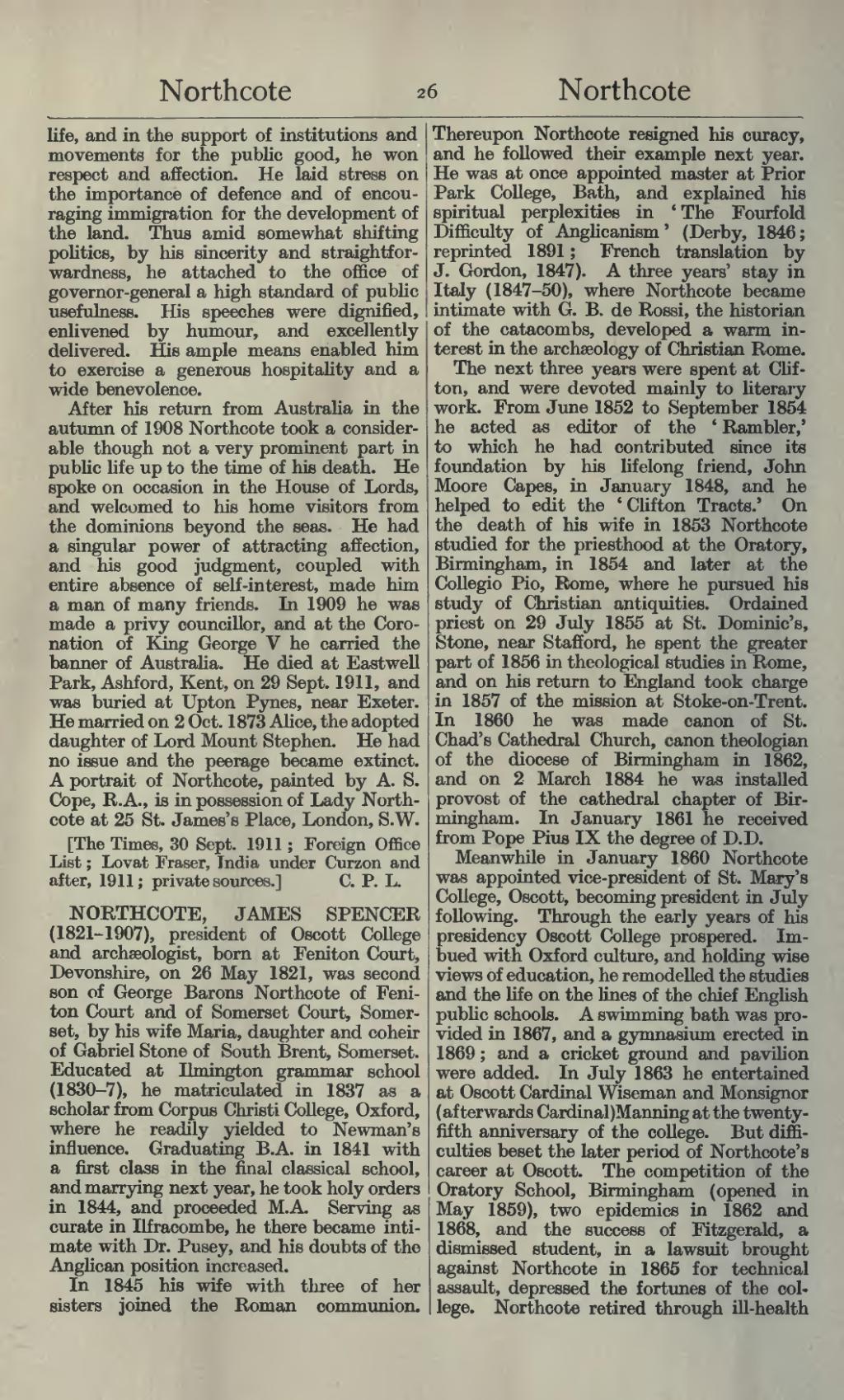life, and in the support of institutions and movements for the public good, he won respect and affection. He laid stress on the importance of defence and of encouraging immigration for the development of the land. Thus amid somewhat shifting politics, by his sincerity and straightforwardness, he attached to the office of governor-general a high standard of public usefulness. His speeches were dignified, enlivened by humour, and excellently delivered. His ample means enabled him to exercise a generous hospitality and a wide benevolence.
After his return from Australia in the autumn of 1908 Northcote took a considerable though not a very prominent part in public life up to the time of his death. He spoke on occasion in the House of Lords, and welcomed to his home visitors from the dominions beyond the seas. He had a singular power of attracting affection, and his good judgment, coupled with entire absence of self-interest, made him a man of many friends. In 1909 he was made a privy councillor, and at the Coronation of King George V he carried the banner of Australia. He died at Eastwell Park, Ashford, Kent, on 29 Sept. 1911, and was buried at Upton Pynes, near Exeter. He married on 2 Oct. 1873 Alice, the adopted daughter of Lord Mount Stephen. He had no issue and the peerage became extinct. A portrait of Northcote, painted by A. S. Cope, R.A., is in possession of Lady Northcote at 25 St. James's Place, London, S.W.
[The Times, 30 Sept. 1911; Foreign Office List; Lovat Fraser, India under Curzon and after, 1911; private sources.]
NORTHCOTE, JAMES SPENCER (1821–1907), president of Oscott College and archæologist, born at Feniton Court, Devonshire, on 26 May 1821, was second son of George Barons Northcote of Feniton Court and of Somerset Court, Somerset, by his wife Maria, daughter and coheir of Gabriel Stone of South Brent, Somerset. Educated at Ilmington grammar school (1830–7), he matriculated in 1837 as a scholar from Corpus Christi College, Oxford, where he readily yielded to Newman's influence. Graduating B.A. in 1841 with a first class in the final classical school, and marrying next year, he took holy orders in 1844, and proceeded M.A. Serving as curate in Ilfracombe, he there became intimate with Dr. Pusey, and his doubts of the Anghcan position increased.
In 1845 his wife with three of her sisters joined the Roman communion. Thereupon Northcote resigned his curacy, and he followed their example next year. He was at once appointed master at Prior Park College, Bath, and explained his spiritual perplexities in 'The Fourfold Difficulty of Anglicanism' (Derby, 1846; reprinted 1891; French translation by J. Gordon, 1847). A three years' stay in Italy (1847-50), where Northcote became intimate with G. B. de Rossi, the historian of the catacombs, developed a warm interest in the archaeology of Christian Rome.
The next three years were spent at Clifton, and were devoted mainly to literary work. From June 1852 to September 1854 he acted as editor of the 'Rambler,' to which he had contributed since its foundation by his lifelong friend, John Moore Capes, in January 1848, and he helped to edit the 'Clifton Tracts.' On the death of his wife in 1853 Northcote studied for the priesthood at the Oratory, Birmingham, in 1854 and later at the Collegio Pio, Rome, where he pursued his study of Christian antiquities. Ordained priest on 29 July 1855 at St. Dominic's, Stone, near Stafford, he spent the greater part of 1856 in theological studies in Rome, and on his return to England took charge in 1857 of the mission at Stoke-on-Trent. In 1860 he was made canon of St. Chad's Cathedral Church, canon theologian of the diocese of Birmingham in 1862, and on 2 March 1884 he was installed provost of the cathedral chapter of Birmingham. In January 1861 he received from Pope Pius IX the degree of D.D.
Meanwhile in January 1860 Northcote was appointed vice-president of St. Mary's College, Oscott, becoming president in July following. Through the early years of his presidency Oscott College prospered. Imbued with Oxford culture, and holding wise views of education, he remodelled the studies and the life on the lines of the chief English pubhc schools. A swimming bath was provided in 1867, and a gymnasium erected in 1869; and a cricket ground and pavilion were added. In July 1863 he entertained at Oscott Cardinal Wiseman and Monsignor (afterwards Cardinal)Manning at the twenty-fifth anniversary of the college. But difficulties beset the later period of Northcote's career at Oscott. The competition of the Oratory School, Birmingham (opened in May 1859), two epidemics in 1862 and 1868, and the success of Fitzgerald, a dismissed student, in a lawsmt brought against Northcote in 1865 for technical assault, depressed the fortunes of the college. Northcote retired through ill-health
